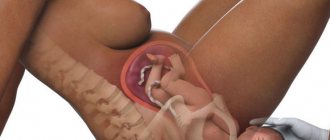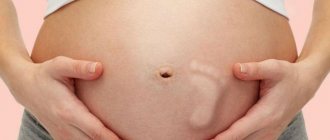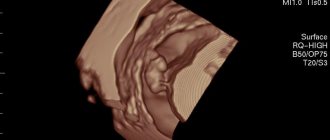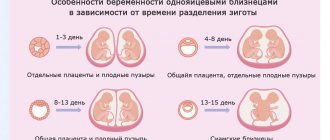“Congratulations, you are pregnant!” – doctors used to say these words more often; with the advent of express pregnancy tests, they can be read in the instructions for the test. In any case, most women call pregnancy and motherhood the most amazing time in their lives.
It is not without reason that they say that a pregnant woman seems to glow from within; she is especially beautiful and attractive during this period. Of course it's a miracle! The expression is a little hackneyed, but, in fact, when a new life arises from a lump of mucus during 40 weeks of pregnancy, there is no other way to call it
Pregnancy is a physiological state of the body. The changes that are taking place are programmed by Mother Nature. These changes are so significant that because of them, a woman’s whole life switches to a new rhythm: about 80% of women feel nausea, especially in the morning; the perception of odors is heightened, some of them cause unpleasant sensations, including severe nausea and vomiting; the usual diet may change - your favorite food may cause disgust, and dishes that were previously on the list of hated foods may appear in first place; increased fatigue; an incomprehensible drowsiness is annoying; frequent urge to urinate; sudden changes in mood; tearfulness.
How pregnancy begins and develops
Fertilization
Every time in the middle of the menstrual cycle, one, rarely several, follicle matures in the ovaries. The follicle contains an egg. The moment the egg is released from the follicle is called ovulation. After release, the egg is picked up by the fallopian tubes and slowly moves towards the uterine cavity. If during this short (3-6 days) period of time a woman has sexual intercourse without means of preventing pregnancy, pregnancy may occur. The egg produces special substances that signal the sperm about where it is. If the “rendezvous” takes place, fertilization occurs. Pregnancy begins.
Fertilization occurs in the fallopian tubes, even before the egg enters the uterine cavity. After the fusion of the egg and sperm, a zygote is formed, from which the growth of the embryo begins.
What happens and what does the embryo look like? How will the size of the embryo change over the weeks? What changes will occur during the process of growth and development? What do photos of an embryo look like by week? Ultrasound is used to observe how the embryo develops over weeks and months.
Diagnosis of pregnancy
Before performing an ultrasound of the pelvic organs, a gynecologist may suspect a short-term pregnancy based on subjective signs. These include the woman’s report of the absence of menstruation and examination data:
- enlargement of the mammary glands;
- bluish tint of the mucous membrane of the vagina, cervix;
- an increase in the size of the uterus from 5-6 weeks, a change in its consistency;
- asymmetry of the uterus with protrusion of the angle in which the embryo is implanted;
- mobility of the uterine body.
To confirm the fact of pregnancy and determine the location of the ovum, an ultrasound examination is performed at a period of 5-8 weeks. If necessary, this diagnostic procedure can be performed repeatedly over short periods of time. One of the indications is a suspicion of late ovulation, when the ultrasound picture does not correspond to the expected gestational age. Changes in the type and size of the embryo over time are correlated with the rate of growth of hCG concentration.
The processes occurring in a woman’s body after conception cause changes in appearance and the appearance of new and unusual symptoms. The first signs of pregnancy are divided into probable, doubtful and reliable. Ultrasound is considered the most reliable method for early diagnosis of pregnancy.
Embryo 1 week
The zygote is still in the fallopian tube on its way to the uterus. The fallopian tubes are lined with villi, which move the egg towards the uterus. If the zygote does not enter the uterus within a certain time, it may attach to the wall of the fallopian tube. In this case, they talk about ectopic pregnancy - a condition dangerous to health and life.
During fertilization, the sperm brings in its 23 chromosomes, which combine with the 23 chromosomes in the egg. Moreover, depending on whether the sperm contains an X or Y chromosome, the gender of the unborn child depends.
After fertilization and the formation of a zygote, about 30 hours pass. The fertilized egg begins to divide. This process is called fragmentation, since with a slight increase in volume, the number of cells grows exponentially and their size decreases. From 1 you get 2, from 2 you get 4, etc. With an increase in cell mass, the gastrula turns into a morula. The morula looks like a spherical collection of cells. By day 7 after fertilization, the morula turns into a blastula. A fluid-filled cavity, or blastocoel, appears in the center of the embryo. The blastula enters the uterine cavity and is immersed in the mucous layer. This process is called implantation and involves the outer shell of the blastula, called the trophoblast. After implantation, trophoblast cells begin to produce human chorionic gonadotropin, an important hormone that supports pregnancy. Human chorionic gonadotropin can be detected in urine, where its presence is determined using a rapid pregnancy test. By the end of the first week, the size of the embryo is only 0.3 mm.
Why does bleeding appear?
They can occur on the days of expected menstruation and more often in women who, even before pregnancy, had problems with the menstrual cycle (when ovulation occurred not in the middle of the cycle, but before menstruation). Call an ambulance quickly: the appearance of such discharge is a reason for a trip to the hospital.
If it turns out that the cause of the events lies in hormonal deficiency, you will need to undergo an examination, and a pregnancy loss specialist will prescribe the necessary therapy for you. If this is due to the incorrect location of the branched chorion, which can be determined during an ultrasound examination, you will be advised to lie down more and take sedatives.
Embryo 2 weeks
On days 8-9 after fertilization, the blastula turns into a gastrula. In this case, the internal cells of the blastula are divided into 3 layers. The outer layer, or ectoderm, will develop into the nervous system and skin. The internal (endoderm) will turn into the cavity of the gastrointestinal tract. The mesoderm, the middle layer, will give rise to the musculoskeletal system (bones, ligaments and cartilage), muscles, kidneys, blood vessels and other internal organs. 10 days after fertilization it is already possible to get a positive pregnancy test result.
Embryo 3 weeks
At week 3, the embryo moves from the gastrula stage to the neurula stage. The ectoderm in the area of the future spine forms a groove that gradually goes deep into the embryo. The edges of the groove are closed. A neural tube has formed that will become the brain and spinal cord. An embryo is formed that will become the baby’s heart.
At week 3, the placenta begins to form - the life support system of the embryo. The trophoblast and part of the ectoderm form the amnion and chorion. The amnion is popularly called the “shirt”. Amniotic fluid collects in the amniotic cavity. The chorion is a villous formation that also produces human chorionic gonadotropin. After some time, with the participation of the mesoderm, the placenta is formed from the chorion. By the end of 3 weeks, the embryo grows to a size of 4 mm.
Embryo 4 weeks
At week 4, the brain and spinal cord begin to form from the neural tube. At the same time, the heart makes its first contraction. Now it will not stop until the very end of life.
The rudiments of arms, legs, eyes, and internal organs are formed. Blood begins to flow in the blood vessels. Before this, the embryo received nutrients from the yolk sac, which, like in birds, contains reserves necessary for the initial stage of development. In addition, the yolk sac in mammals plays the role of the liver, bone marrow, and kidneys. It is the yolk sac that contains future germ cells, which migrate from it to the primordia of the gonads. After the appearance of the corresponding organs in the baby, it gradually disappears by the end of the first trimester.
How baby's size changes
Embryo development is an exciting process that interests every mother. After IVF, women sometimes feel the onset of pregnancy, the embryo - first a pulling sensation, then a tingling sensation in the abdomen. After the test reveals pregnancy, the embryo needs to be taken care of - don’t be nervous, eat right, take walks. After all, successful embryo insertion and conception are only the first steps towards the birth of a baby.
Active recreation is not advisable at this time. You need to experience more positive emotions, and also prepare for upcoming motherhood. Women read books on child care and admire the first ultrasound images. Until the second trimester, the development of the embryo goes unnoticed - the woman’s tummy protrudes slightly. The abdomen begins to actively grow towards the end of the second trimester, when the development of the embryo enters the stage of active growth. The fetus gains mass and grows, gradually begins to move and respond to sounds. Changes are observed every week of pregnancy, the embryo develops rapidly. You can track your child's height and weight at each stage using abdominal images. At this time, the baby's size is measured in millimeters.
The growth and weight of the embryo is monitored from the second trimester of pregnancy; at this time the embryo begins to grow rapidly. These parameters are quite individual; all babies gain weight differently. At this stage, it is not the size of the child that is important, but its proper development. However, for those who still want to compare the size and weight of their child with the “standards”, a special obstetric table will help.
Embryo by week of pregnancy:
Don't worry if your child weighs slightly less than normal for his age. The doctor would definitely pay attention if something in the development of the fetus went wrong.
Study the development of your baby, watch how he grows and rejoice in the fact that you will soon have a child!
Embryo 5 - 6 weeks
Embryo. 5 weeks from the moment of fertilization.
At 5 weeks, the umbilical cord is formed, which will connect the baby to the placenta. The umbilical cord contains arteries and veins. The length of the umbilical cord by the end of childbirth can reach 70 cm. At the 5th week, the arms and legs look like flippers, but individual details can already be distinguished. The first impulses begin to be generated in the nervous system - the basis of nervous activity. The head of the embryo is formed, and holes for the ears, eyes, mouth and nose appear in it. The length of the embryo reaches 1 cm.
Embryo. 6 weeks from the moment of fertilization.
At week 6, it is already possible to distinguish the features of the future face. Limbs and fingers are developing. The baby begins to make his first movements. The pigment that determines the color of the eyes is formed on the iris. At week 6, the embryo's heartbeat can be seen and heard using an ultrasound scanner or ultrasound. The placenta is fully formed. The rudiments of the lungs, kidneys, gonads, stomach and intestines are formed. Amniotic fluid already surrounds the embryo. The 6th week of pregnancy in Western countries is considered the optimal time for the first visit to a gynecologist. It is necessary to do an ultrasound, undergo a series of tests, and undergo an examination by specialized specialists.
29-32 weeks
The third trimester of pregnancy has arrived.
During this last trimester of pregnancy, your baby is growing, storing fat, and his organs are slowly maturing. By 32 weeks of pregnancy, your baby will be about 40 centimeters long and will weigh up to 2 kg.
At this time, the child may exhibit high motor activity and even “hiccup” (so-called hiccup-like movements)! This is how the child practices breathing and trains the respiratory muscles.
Read about 29-32 weeks of pregnancy...
Embryo 8 weeks
The kidneys begin to produce urine. Hair follicles form in the skin. Almost all vital organs have already been formed. Reflexes and feelings are triggered. Ears form, the face no longer looks like an alien from a science fiction movie. It is clearly visible that a person is growing. The bones are still made of cartilage, but later they will be saturated with calcium and turn into real bone tissue. This process will be completely completed only by the age of 25, long after birth. The size of the embryo is almost 2 cm.
Embryo 10 weeks
The baby's eyelids close. He will open them himself at 28 weeks. The respiratory system is almost completely formed. The skeleton and its structure fully correspond to a person. The arms and legs are lengthened to normal proportions. But the head occupies almost half the length of the body. This is due to the active development of the cerebral hemispheres, the cerebellum is growing. The external genitalia develop according to gender. You will soon find out if he or she is growing in your belly. The baby's blood acquires its own group and Rh factor. Height can reach 7-8 cm.
Recommendations from a gynecologist for a future mother
First of all, try to sleep at least 8-10 hours, go to bed early and try to rest during the day. All this is necessary so that the future baby is comfortable in your stomach and receives the necessary amount of nutrients and oxygen (and all this comes to him through your blood). Spend more time in the fresh air, for example, take a walk with your husband before going to bed. If you feel nauseous in the morning, eat a cookie or an apple before getting out of bed. This problem often occurs due to the fact that blood sugar levels are low in the morning, and a small “snack” will help you quickly bring it back to normal.
Radical life changes will be needed only if your work involves the risk of contracting infections, if you spend a lot of time in contact with chemicals or with a computer. In this case, you should think about taking a vacation without waiting for maternity leave. The fact is that in the first 8 weeks, all the organs and systems of the unborn child are formed, and any harmful influence (chemicals, radiation, viruses, nicotine, alcohol) can disrupt this important process. And one more thing: during the first ultrasound examination, the doctor will determine where the placenta is: if it is located normally and there are no problems during pregnancy, then you should not deny yourself sex.
Embryo 11 weeks
The baby has a hairstyle. The fine hair on the head and body is called lanugo. They usually fall out by the time of birth. The skin is almost transparent, blood vessels are visible. The first foci of ossification form in the bones. White blood cells - leukocytes - appear in the blood. The arms are pulled up to the face, the baby can put a finger in the mouth. We begin to do exercises - the baby can actively move in the womb, but its size (10-15 cm) and low weight (30 g) do not yet allow the mother to properly feel these movements.
Embryo 12 weeks - 13 weeks
Embryo 12 weeks. Photo
During this period, you can visit a doctor and have an ultrasound examination done in 3D reconstruction mode. Here is your baby's first portrait. Ultrasound can determine the sex of the child with almost 100% accuracy. During an ultrasound, screening for developmental pathologies is carried out. The finger can now be sucked - the sucking reflex has appeared. The liver and pancreas produce secretions. Meconium is formed in the intestines - original feces. The formation of the genital organs is completed. The baby's height is about 15 cm, weight 40-50 g. Despite the fact that the child is so small, he is already a person. All organs are in their places, now his body will be more resistant to negative influences. All that remains is to grow. The first trimester is over.
What examinations are performed during pregnancy?
The word “pregnancy” comes from the word “burden.” Pregnancy is a significant burden on a woman’s entire body. Therefore, if the pregnancy is planned, try to cure your chronic diseases first. If you did not expect pregnancy, but, nevertheless, it turned out to be desired, consult a doctor as soon as possible. You will be examined, treatment will be selected and all necessary recommendations will be given for further pregnancy.
If you are healthy, you will just need to get tested.
- Analysis for syphilis, HIV infection, hepatitis B and C. The first time this test is taken is at the first visit to the antenatal clinic. You will have to retake it once every 3 months (3 times during the entire pregnancy).
- A general blood test will have to be taken monthly. The doctor will be interested in the level of hemoglobin, the number of leukocytes, platelets, and ESR.
- A biochemical blood test is also taken once a month. It can be used to judge how the internal organs function, primarily the liver and kidneys.
- A general urine test in the first and second trimesters is taken once a month, then once every 2 weeks, and after 36 weeks - weekly.
- Analysis to determine blood type and Rh factor. Rent once. However, if you have Rh negative blood and your husband has positive blood, you will have to determine the amount of Rh antibodies in your blood monthly, and more often if necessary. This is very important for identifying Rh conflict between the organisms of the mother and fetus.
- Coagulogram. Changes in the blood coagulation system are determined monthly. This is very important, because the mother’s blood provides nutrition to the baby.
- Testing for sexually transmitted diseases (chlamydia, mycoplasma, ureaplasma, viral infection) is done either before pregnancy or in the early stages. If necessary, for example, if there are signs of intrauterine infection, the tests will have to be repeated.
- Ultrasound for uncomplicated pregnancy is performed at 20-24 and 36 weeks. According to indications, this study can be performed more often, since it does not have a negative effect on the mother and fetus.
- At 16-20 weeks of pregnancy, it is necessary to take an analysis for possible fetal malformations - determine the level of alpha-fetoprotein, human chorionic gonadotropin and unconjugated estriol in the blood.
- After 34 weeks of pregnancy, fetal cardiotocography (CTG) is indicated once every 2 weeks to assess its intrauterine condition.
- Pregnant women are required to be examined by a therapist, ophthalmologist, ENT doctor, or dentist.
- The need for other studies is discussed individually with the doctor leading the pregnancy.
Embryo 16 weeks -19 weeks
Marigolds appeared on my fingers. Taste buds on the tongue can sense taste, and receptors in the nose can sense smell. Mom may or may not like the foods she eats. Fully formed ears make it possible to hear sounds. Including mom's heartbeat. Recent research has led to an original practical application - soft toys are made for newborn children that reproduce the mother's heartbeat. It is believed that a calm, measured heartbeat calms the baby. Try not to be nervous. The eyes begin to discern light.
And of course, during this period, mothers begin to feel the baby’s movements inside them. There is feedback from the mother. The baby can sleep and be awake, this is noticeable by periods when no movements are felt. Baby's height is 20 cm and weight is up to 250 g.
The course of pregnancy by week
Mother's well-being at twenty-fifth week
The expectant mother's belly is growing and her weight is steadily gaining (approximately 350 g per week). Now it is important to control your salt intake in order to avoid possible swelling. They can be not only unpleasant, but also quite dangerous. Mom feels great, but it is very important not to overload herself and take care of herself. A woman constantly needs positive emotions, good sleep and rest. This week, the fundus of the uterus rises above the pubis by 25 cm. If this distance is less, the doctor may note a delay in the development of the baby, so control is important. An enlarged uterus can limit physical exercise and the duration of walks, so it is very important for the mother to choose comfortable shoes and clothes; a bandage will help make the condition more comfortable. This week it is necessary to monitor the level of hemoglobin in the blood. Evidence of its decrease may be rapid fatigue, shortness of breath, and rapid heartbeat. This is a period of very active iron consumption, which is so important for the baby’s future. In this case, anemia may develop. It is not a disease, but is physiological in nature (occurs exclusively during pregnancy). Prescribing special iron supplements can always correct the situation and bring hemoglobin levels back to normal.
What happens to the baby at the twenty-sixth week of pregnancy
The baby continues to develop and grow, his weight has already reached 900 g, and his height is 34 cm. During this period, the baby will be able to survive if he decides to be born prematurely. In the second trimester, all the organs of the little man are practically formed. The intensity of the little one's movements and the force of his kicks are becoming stronger, and the mother may feel uncomfortable and painful. The baby has a lot of space, which allows him to tumble and move actively. Although it is already fully formed, the body is still small and thin. Basically, a baby gains weight by accumulating fat and due to muscle growth. The baby is able to distinguish the taste of amniotic fluid, which changes in accordance with what the mother ate. Lung tissue is now being actively formed; it plays an important role in the respiratory system of a small organism. Within a week, the baby’s reproductive system effectively develops; in boys, the testicles begin to move into the scrotum, and in girls, the genitals and vagina are formed. The baby can already clearly distinguish the voices of his relatives, recognizes his mother’s voice, familiar sounds. Therefore, now you can sing lullabies to him. The baby hears the mother's heartbeat and after birth will be able to fall asleep better if he is placed to the breast. The baby can already distinguish between light and dark, and his eyeballs continue to form.
What happens to the mother at the twenty-sixth week of pregnancy
The already significantly enlarged tummy begins to restrict breathing (you want to take a deep breath), shortness of breath may appear. This week, the mother's total weight may increase by approximately nine kilograms. It is more difficult for the expectant mother to walk; a bandage, comfortable clothes and shoes will help alleviate the condition. Now it is important for a woman to spend a lot of time outdoors, increasing the number or time of walks. The mother's visual acuity may also decrease, but this is a temporary phenomenon. The fundus of the uterus rises to a distance of 26 cm from the pubis. The uterus grows approximately 1 cm per week, putting pressure on other organs. This week, mom can attend special sports sections and provide herself with moderate physical activity. It is not recommended to stay in a sitting or lying position for a long time.
Women are now concerned about the appearance of age spots on the skin. There are no effective remedies against this; mom needs to be patient and just wait. After childbirth, the skin condition returns to normal. Training contractions may appear this week; they are not dangerous, but if they occur, you should notify your doctor. It is very important for an expectant mother to protect herself from stress; the support and care of loved ones can help with this. For a woman, home-cooked food is preferable; it is important to split portions and eat food often and in small quantities. This will help reduce the discomfort from heartburn and nausea that are possible this week. The process is completely natural; the enlarged uterus puts pressure on the organs of the digestive system and displaces them.
How the baby develops at the twenty-seventh week of pregnancy
Active movements and growth are characteristic of the baby this week. He still has enough space in his mother’s tummy and nothing hinders his movements. The baby actively moves its arms and legs and can still roll over if it is positioned with its head up. The strength of his thrusts increases, and this is due to constant training and an increase in muscle mass. The baby is actively preparing for birth, training its arms and legs. From this period, the endocrine system and its important part, the pituitary gland, develop, which plays a huge role in the growth of the baby. The thyroid gland is activated, producing important hormones that regulate metabolism in the body. The production of hormones this week allows the baby to provide for its own needs, because until this moment the mother’s hormones played the main role. This week is the main one in the formation of the baby’s individual metabolic system and his reaction to many events and processes in life. The baby’s weight also increases, reaching 1000 g, and the length of the baby’s body is 34 cm. The baby’s body is covered with vellus hairs, and there are small soft marigolds on the fingers. The lungs continue to develop and train for the birth of a baby. The baby receives oxygen through the placenta. The baby begins to distinguish colors and can turn its head towards the light source, can feel pain and clench its tiny fists.
What does the expectant mother feel at the twenty-seventh week of pregnancy?
Things are getting a little more difficult for mom this week. The baby's activity may cause pain. A woman’s mood often changes, and during this period the support and care of loved ones is especially important. Mom may have experiences and fears that should not be kept silent; it is better to share them with her husband or friends. On the physiological side, swelling, dizziness and increased weather sensitivity may occur. Stretching skin on the tummy often begins to itch, and a special cream can help in this case. During this period, a woman’s uterus is located at a distance of approximately 28 cm from the pubis. The mother continues to gain weight due to an increase in the amount of amniotic fluid, the weight of the placenta and the baby. Under the weight of the belly, a woman’s posture may change, lower back pain and excessive sweating may appear. It is better for a woman to rest lying on her side; sleeping on her back should be minimized. Swimming lessons in the pool would be ideal for mom and baby. Due to the fact that the baby’s endocrine system begins to work independently, changing hormonal levels, the mother’s well-being improves. This week, cramps may appear, you should not be afraid of this, the phenomena will pass after childbirth. Changes in body position, a special cream, and light massage of this area will help minimize discomfort.
Baby at twenty-eight weeks
This week the baby already reaches 1,200 g, and his height is 35 cm. The baby’s body takes on a more rounded shape, the folds are smoothed out, and he becomes more and more like a newborn. Tiny tufts of hair gradually begin to fall out, remaining in the area of the shoulders, back and lower back. The hairs on the head, eyebrows and eyelashes gradually darken, and you can already guess what color they will be after birth. The baby can distinguish sounds and voices better and better; at this time, you can play lullabies so that he begins to get used to them. The baby is already beginning to blink his eyes and open his eyelids a little. The weight of the brain increases, and grooves appear on its surface. More and more, the baby begins to distinguish the taste of foods. Mom’s preferences in tastes and smells will be passed on to the baby, since from this period he begins to get used to what mom loves and eats. The baby's skeleton has almost formed, but the bones remain soft, and they will continue to harden even after the baby is born.
This week is also important for the formation of the baby’s psyche and character. It may happen that the baby will be more active at night than during the day. Don't worry, during the day when mom walks, the baby rocks in her tummy and falls asleep. Therefore, its activity at night is quite understandable.
Changes in mom at twenty-eight weeks
Mom's weight gain this week reaches approximately 10 kg, the uterus rises 28 cm from the pubis. Now it is very important to take care of yourself, avoid falls and not overwork. Mom feels the baby’s movements very well, because he has grown significantly and began to take up more space in the woman’s tummy. The movements have become much stronger, and the tremors are now more painful. The baby spends more time awake, and the period of his activity has also increased significantly. The condition of the mother now significantly affects the condition of the baby. If mom is nervous, the baby will also be restless. Also, a lot depends on the mother’s diet: eating sweets will give the baby energy and make him active. The woman also experiences increased pain in the lower back, back and legs, she is more likely to get tired and suffer from shortness of breath. It is important to choose a comfortable position for sleep, and this is becoming increasingly difficult to do. Mom is becoming less and less agile, her thought processes are slowing down. This week there is a threat of miscarriage; a woman’s blood pressure may also increase and, as a result, her health may worsen. It is important for mom to eat a variety of foods: it should be divided into small portions that should be consumed frequently. Since the baby is actively growing, he needs more and more space; if the mother’s stomach and intestines are full, the baby will not like it. A woman experiences training contractions, her stomach may pull, and pain in the lower back intensifies. In this case, it is also recommended to wear a bandage and rest more.
Embryo 20 weeks -30 weeks
Did you feel the kick? Now the baby communicates with his mother this way. If mom is sad, upset about something, or there is loud music around, it’s smoky, stuffy, the baby violently expresses his opinion. At first it’s timid, but by the end of pregnancy this method of communication will no longer cause tenderness. Constantly getting kicked from the inside can be quite painful. A sudden noise or fright of the mother leads to a similar response from the child. Protective reflexes arise.
In the lungs, the formation of respiratory alveoli is completed. Fingerprints form on hands. Brain development occurs at the fastest rate. Neural connections are formed. The baby can blink. The immune system is formed. The respiratory organs are developed enough to provide breathing in the event of premature birth, but sometimes only with medical assistance and special equipment. Adipose tissue appears. By 30 weeks, growth reaches 40-43 cm, weight up to 1.5 kg.










